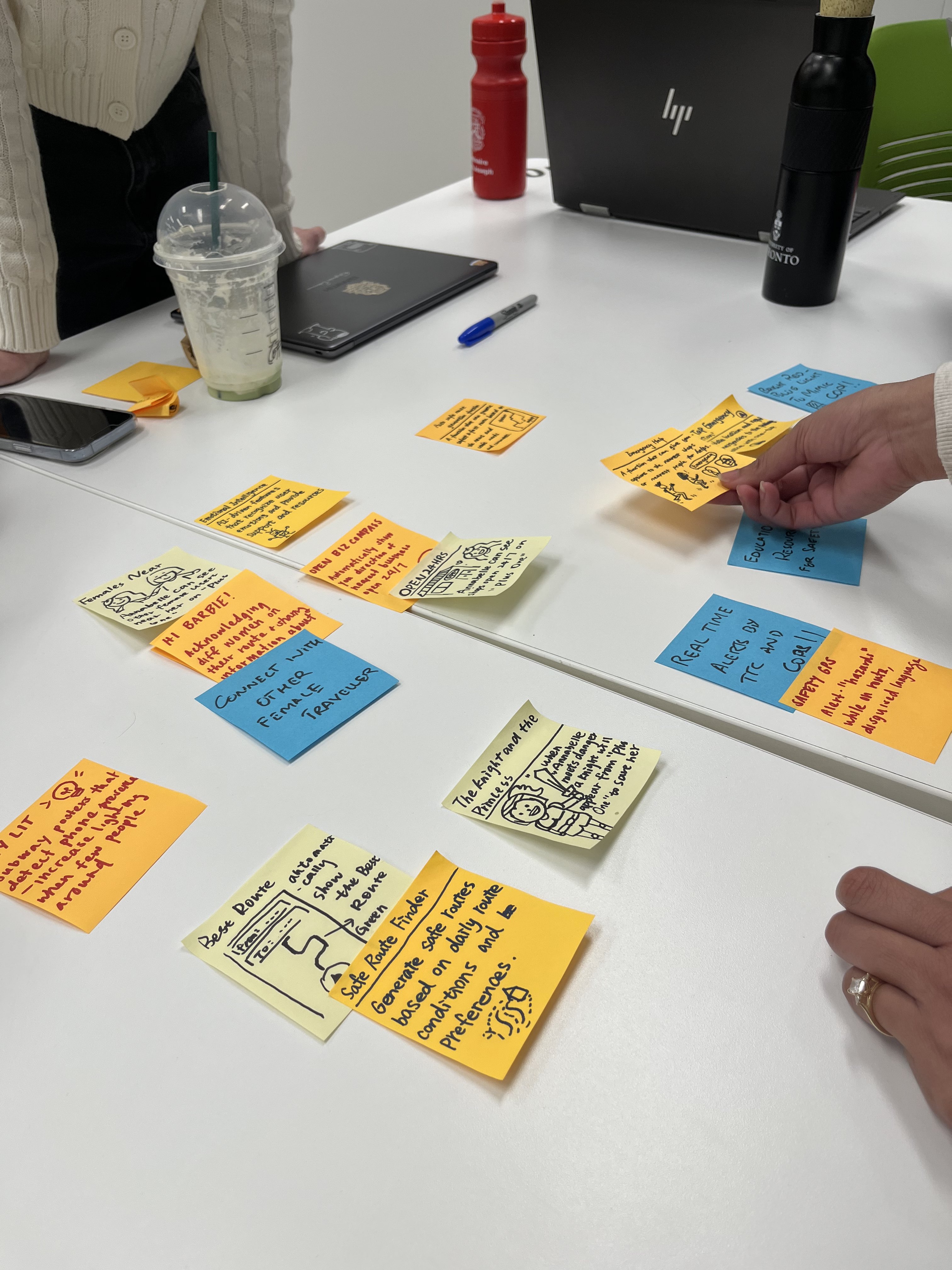WanderSafe
How can we enhance the commuting experience for females like Annabella in Toronto, ensuring their sense of safety and well-being?
Introduction
Based on our female team members' unpleasant commuting experience in Toronto, we developed the idea to design an App to solve women's commuting safety concerns in Toronto.
WanderSafe is a map-based mobile app designed to enhance the commuting experience for women in Toronto by prioritizing safety. It's a story of innovation, resilience, and problem-solving, and I'm thrilled to share this intimate look at the process that led to the successful completion of this endeavor.
Team Members
Alexis Michaud, Ashfaaq II Mohammed, Beibei Hu, Fan Fei, Jeanelle Suarez, Xinlu Chen
My Role
Research Studio Leader, Ideation, Wireframes, Low Fidelity Design, Mid Fidelity Design, Usability Testing
Tool
Figma, Miro
Skills Developed
UX Research, Wireframing, Prototyping, Usability Testing
Project Length
8 weeks

Findings from Interviews and Surveys
Most women use public transportation to get around the city.
The night hours, especially after 6:00 pm, are often labeled as "unsafe" or "scary"。
Women feel particularly concerned when taking the subway to get around.
Women adopt a variety of methods to increase their perceived safety while traveling, like looking around and decrease the music volume.
When asked about TTC services, several women are skeptical about whether they would work.
Several women mentioned that their feeling of safety varies across different cities. They have indicated feeling safer in Toronto compared to cities where there is a higher rate of crime.
Toronto is often described as less safe than other cities in Canada or Asia.
Building Empathy with Annabella
Using the quantitative and qualitative data from interviews and survey results, we defined our target user — "The Anxious Fella" Anabella (Marketing Coordinator, 22), a girl who works in Toronto but originally came from a small city.
Addressing Annabella's Needs
Recognizing the challenges encountered by Annabella and numerous women facing similar situations, we dedicated ourselves to tackle Annabella's needs and engaged in a brainstorming session to generate ideas.
We labeled each group around the value offered to Annabella, in relation to her needs.
We each voted on our favourite ideas based on what would make the biggest difference in Annabella’s travels (3 blue dots/member) as well as which ideas were the fastest to implement (3 purple dots/member).
What can make a difference ?
After seeing the ideas in proximity to each other, we debated the feasibility and impact of each idea and slightly adjusted the prioritization accordingly. From these adjustments, our top three ideas are:
Safe Route Finder (Home Run): Generate safe routes based on daily route conditions and preference. Based on our research, “safe” conditions would include adequate lighting, populated crowds, familiarity of the route, and open facilities.
Annabella Alert (Big Bet): Real-time alerts from TTC and police as reports come in.
Fake Call (Quick Win): Receive a "fake call" to deter people.
Our Design Goals
Based on Annabella's Needs and our ideas, We decided to design a mobile app 'WanderSafe' which can help women feel safe while commuting in Toronto.
By using WanderSafe, Annabella can:
promptly find a travel route based on her safety criteria to lift the burden of selecting a route on her own
get to the nearest open facility without spending time searching through a map
learn of route conditions in real-time without constantly worrying about unpredictable situations
Wireframing the Solution
After reconsidering the top three voted ideas, we have narrowed our ideas to 3 solutions that give Annabella the safest, most comfortable commute within the city and implement them on WanderSafe.
1. Travel route based on her criteria
2. Nearest open facility
3. Real-time route conditions
Subsequently, we proceeded to develop both low-fidelity (low-fi) and mid-fidelity (mid-fi) wireframes for the WanderSafe application.
Low-fi Wireframe
Mid-fi Wireframe
Based on low-fi wireframe usability testing, we improved several aspects in our Mid-fi design
Route Options:
Improve clarity and encourage exploration in all optionsGraphical & Textual Description:
Refine textual explanations of features
Improve the recognizability in iconsNavigation Flow:
Optimize navigation process
Usability Testing
The usability test consisted of conducting approx 20-minutes testing sessions with 3 typical users that fit WanderSafe's target user demographic.
Method 1: Observation of Usability Test
Observe how users navigate and complete scripted tasks to spot any usability issues in WanderSafe, and ask users to think aloud.
Tasks include: 1. Navigate a trip 2. Update the route upon receiving the alert. 3. Find the nearest open facility.
Method 2: Interview / Feedback
Collect feedback from the usability test and subsequent questionnaire to unravel all possible problems.
Our Next Steps !
Iterate: Implement participant feedback from evaluation testing into prototypes
Re-test: Perform another round of usability testing to validate changes made have positive impact
Accessibility: Conduct tests for accessibility and compliance with accessibility standards of the app, and iterate if required
Documentation: Document the changes made and the rationale behind those changes
Advance: Advance prototype fidelity to Hi-Fi, incorporating design elements, interactions and functionality and iterate
Conclusion & Challenges
Think Twice: Feedback from industry highlighted concerns about the potential for malicious use when sharing location with other female users during onboarding process.
Time Matters: Due to time constraints, certain features, such as safety ratings for different communities in Toronto, couldn't be included in the wireframe.
Empathize with Users: The project also involved explaining aspects of females' commuting experiences, like holding keys while walking or texting family in Uber, to male group members. It highlights the importance of empathizing with our users.
Women Power: Throughout the project, we addressed the underrepresentation of female designers in the UX market, emphasizing the lack of effective safety apps for women.
Design for social justice: This experience underscored the long-standing neglect of marginalized groups in the design process, revealing the potential for technology to recognize and address such issues, contributing to social justice.



























